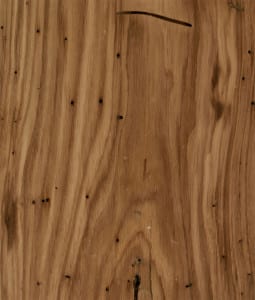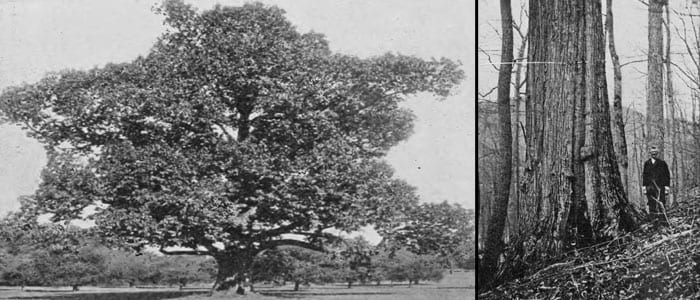The American Chestnut (Castanea dentata), a member of the beech family (Fagaceae), was once the most important forest tree throughout much of the eastern United States and southeasternmost Canada. A rapidly growing tall and broad deciduous hardwood tree, it reached up to 45 m (150 feet) tall, 30 m (100 feet) across, with a trunk up to 3 m (10 feet) in diameter, and ranged from Maine and southern Ontario to Mississippi, and from the Atlantic coast to the Appalachians and the Ohio valley. There are several related chestnut species such as the European Sweet Chestnut, Chinese Chestnut and Japanese Chestnut, which are distinguishable from the American species. C. dentata can be best identified by the larger and more widely spaced saw-teeth on the edges of its leaves, as indicated by the scientific name dentata, Latin for “toothed”. The leaves, which are 14-20 cm long and 7-10 cm broad, also tend to average slightly shorter and broader than those of the Sweet Chestnut (16-28 cm by 5-9 cm).
The American Chestnut is a prolific bearer of nuts, usually with three nuts enclosed in each spiny green burr, and lined in tan velvet. The nuts develop through late summer, the burrs opening and falling to the ground near the first fall frost.
 The American chestnut was a very important tree for wildlife, providing much of the fall mast for species such as White-tailed Deer and Wild Turkey and formerly the Passenger Pigeon. Black Bears were also known to eat the nuts to fatten up for the winter (and still do in those rare instances where they can still encounter the nuts.)
The American chestnut was a very important tree for wildlife, providing much of the fall mast for species such as White-tailed Deer and Wild Turkey and formerly the Passenger Pigeon. Black Bears were also known to eat the nuts to fatten up for the winter (and still do in those rare instances where they can still encounter the nuts.)
The wood is straight grained, strong as oak, although easier to saw and more easily split, lacking the radial end grain found on most other hardwoods. The tree was particularly valuable commercially since it would grow at a faster rate than oaks. Being rich in tannins, the wood was highly resistant to decay and therefore used for a variety of purposes, including furniture, split-rail fences, shingles, home construction, flooring, piers, plywood, paperpulp, and telephone poles. Tannins were also extracted from the bark for tanning leather. Although larger trees are no longer available for milling, much chestnut wood has been reclaimed from historic barns to be refashioned into furniture and other items. “Wormy” chestnut refers to a defective grade of wood that has insect damage, having been sawn from long-dead blight-killed trees. This “wormy” wood has since become fashionable for its rustic character.
